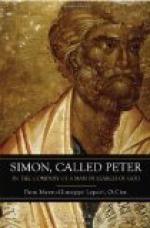“Not a scrap, old man,” said Pennell, “I’ll come in too.”
Peter walked up to a padded leather-covered door and pushed. It swung open. They stepped in, into a faintly broken silence, and stood still.
Objects loomed up indistinctly—great columns, altars, pews. Far away a light flickered and twinkled, and from the top of the aisle across the church from the door by which they had entered a radiance glowed and lost itself in the black spaces of the high roof and wide nave. Peter crossed towards that side, and his companion followed. They trod softly, like good Englishmen in church, and they moved up the aisle a little to see more clearly; and so, having reached a place from which much was visible, remained standing for a few seconds.
The light streamed from an altar, and from candles above it set around a figure of the Mother of God. In front knelt a priest, and behind him, straggling back in the pews, a score or so of women, some children, and a blue-coated French soldier or two. The priest’s voice sounded thin and low: neither could hear what he said; the congregation made rapid responses regularly, but eliding the, to them, familiar words. There was, then, the murmur of repeated prayer, like muffled knocking on a door, and nothing more.
“Let’s go,” whispered Pennell at last.
They went out, and shut the door softly behind them. As they did so, some other door was opened noisily and banged, while footsteps began to drag slowly across the stone floor and up the aisle they had come down. The new-comer subsided into a pew with a clatter on the boards, but the murmured prayers went on unbroken.
Outside the street engulfed them. The same faces passed by. A street-car banged and clattered up towards the centre of the town, packed with jovial people. Pennell looked towards it half longingly. “Great Scott, Graham! I wish, now, we hadn’t come away so soon,” he said.
CHAPTER VIII
The lower valley of the Seine is one of the most beautiful and interesting river-stretches in Northern Europe. It was the High Street of old Normandy, and feuda, barons and medieval monks have left their mark upon it. From the castle of Tancarville to the abbey of Jumieges you can read the story of their doings; or when you stand in the Roman circus at Lillebonne, or enter the ancient cloister of M. Maeterlinck’s modern residence at St. Wandrille, see plainly enough the writing of a still older legend, such as appeared, once, on the wall of a palace in Babylon. On the left bank steep hills, originally wholly clothed with forest and still thickly wooded, run down to the river with few breaks in them, each break, however, being garrisoned by an ancient town. Of these, Caudebec stands unrivalled. On the right bank the flat plain of Normandy stretches to the sky-line, pink-and-white in spring with miles of apple-orchards. The white clouds chase across its fair blue sky, driven by the winds from the sea, and tall poplars rise in their uniform rows along the river as if to guard a Paradise.




